
Resupply at Muir Trail Ranch
Resupply options on the John Muir Trail are fairly straightforward in the northern section, but it gets a little more complicated in the rugged, southern section where no backcountry ranches exist. For those with a strict timetable, it may be undesirable to have to spend a couple of days exiting the trail to get to a town to resupply on the John Muir Trail. This is different from other long trails, such as the Appalachian Trail, where the trail goes through or very near towns. The JMT is actually part of the Pacific Crest Trail (PCT) but even here, there are differences between the typical JMT vs PCT hiker. Since the JMT can be hiked in two to three weeks, it’s possible to sandwich it in between other of life’s responsibilities whereas the average PCT hiker has had to commit five or six months and may not feel the time pressure so intensely.
Food planning can be a daunting task. Options include purchasing backpacking meals or making your own. For those who want to make their own, there are choices between dehydrating whole meals or creating meals from individual dried ingredients. There are many sources for freeze-dried or dehydrated ingredients for those who don’t want to dehydrate their own. It costs a little more to purchase ingredients but dehydrating foods can be time-consuming. In the northern part of the trail, there are a few places where fuel and freeze-dried meals can be purchased, though the selection may be limited. Others may prefer to mail food packages to be assured of the foods they prefer.
Resupply options are fairly straightforward in the northern section of the JMT between Yosemite and Muir Trail Ranch (MTR), where the trail skirts roads, a town, and two pack stations. There are several locations where meals, fuel, and hiker-friendly freeze-dried and fresh food can be purchased, though the selection may be limited. Others may prefer to mail resupply packages to be certain they have the food they prefer. Each facility has requirements and specifications for packaging and mailing so check websites carefully or contact them for the latest information.
It gets a little more complicated in the rugged, southern section of the Sierra where there are no towns within easy reach of the trail and no visitors centers, stores, or pack stations.
There may be permit restrictions that can affect resupply options. These have been in flux so read current permit regulations carefully to be sure it is possible to legally leave the trail to resupply.
From north to south, here are the resupply options.
Yosemite Valley, the main tourist hub in Yosemite National Park, is where SOBO hikers start the trail if they have a permit to begin at the Northern Terminus of the trail at Happy Isles. The Village Store in Yosemite Valley is fairly large and is stocked with freeze-dried and fresh ingredients. It’s a good place to pick up last-minute items before the hike starts.
There is a US post office if a resupply package needs to be mailed ahead.
[Your Name]
c\o General Delivery
Yosemite Valley, CA 95389-9906
The next location for resupply is Tuolumne Meadows, 22 trail miles from Yosemite Valley. The Tuolumne Meadows Store is a very small store with a limited supply of freeze-dried meals and snacks. The Tuolumne Meadows Grill serves breakfast, burgers, and ice cream. A post office (phone number: (209) 372-8236) is located in the same building as the store and cafe. Mailed resupply packages may be sent here. The post office is closed on Sundays and federal holidays but employees at the store may be able to retrieve packages. To mail packages to athepost office, use this format for the label:
[Your Name]
c\o General Delivery
Tuolumne Meadows, CA 95389-9906
Services at Tuolumne Meadows are closed in winter. They generally open at the end of May and close at the end of September, but it depends on snowfall and whether Tioga Road has been plowed. In heavy snow years the opening date may be delayed weeks. View Tioga Road Historical Seasonal Opening and Closing Dates. If the TM PO is closed, packages will be held at the PO in Yosemite Valley.
Resupplies may be dropped off at food storage lockers (bear boxes) at any of the trailheads or at the Wilderness Center. Label the packages with your name and expected pickup date.
Reds Meadow Valley is an area where Reds Meadow Campground, other US Forest Service campgrounds and Red’s Meadow Resort are located. It is about 60 miles from Yosemite. The rustic resort is a backcountry pack station that includes the Mule House Cafe, a general store, and cabins. They accept mailed resupply packages and sell fuel, freeze-dried meals, cheese, tortillas, fresh foods, breakfast items, beer, and wine. They are usually well-stocked, though specific items vary and may be in short supply at times. Due to the proximity to a shuttle bus stop and the town of Mammoth Lakes, Reds Meadow is a convenient place to resupply.
Cardboard boxes or plastic buckets may be used to mail food via US Postal Service only. They will accept a drop off of resupply packages.
Red’s Meadow Resort usually opens in mid-June and closes October 1, depending on snow levels and other factors (including when the seasonal road is open). In dry years, they might open in early June, while in big snow years, they might not open until late July. Last year, they opened on June 26 and closed October 1 for resupply.

Red’s Meadow Resort has a store with fresh and dry foods for backpackers.
Located six miles from Reds Meadow, Mammoth Lakes (population 8,127) offers all the amenities of a thriving mountain town. The shuttle bus costs just a few dollars (less than $10) and connects to a network of free shuttles in town. Mammoth is well equipped with many restaurants, large and small grocery stores (Vons Supermarket and Pharmacy is the largest), pharmacies, and sporting goods stores (such as Mammoth Mountaineering Supply) where equipment can be replaced. Resupply packages may be mailed to the Mammoth Lakes post office. See the Tuolumne Meadows section above for the label format.
Vermilion Valley Ranch is not on the trail, being over four miles from Mono Creek, but it is close. The ferry, if it’s running, can shave off some time and effort. It’s a hiker-friendly place that is a popular resupply option. Trekkers can stay overnight in a tent, yurt or RV, purchase food, eat at the restaurant, and mail packages. It’s relatively close to MTR so some choose one or the other while others take advantage of both. It is accessible via a narrow, curvy road from the west for those wishing to start or end their trip at VVR, though most hikers find logistics easier to manage from the east side of the Sierra.
Cardboard boxes or plastic buckets may be used to mail food via UPS/FedEx or the US Postal Service (separate addresses are provided on the VVR website).
VVR usually opens in late May and closes in late September. One year, they opened on May 20 and closed September 30.
Muir Trail Ranch is a scant 0.6 mile off the trail and 20 miles from VVR. It is the last convenient resupply option going SOBO. For this reason, it is a popular place to resupply. The primary business of MTR is to serve guests who stay in the cabins. Resupply is a side business that offers convenience to hikers but getting resupplies into this remote location is not easy. For a variety of reasons, MTR has strict rules that govern their service so hikers are advised to carefully read the information on their website and understand what services they provide to hikers who are not paying guests. They accept mailed resupplies but the tiny store stocks only a small supply of sundries and does not sell any food or beverages. In peak season, rejected supplies from other hikers may be used to supplement a mailed resupply but this can be skimpy at times. Only paying customers have access to MTR’s meals and hot springs. There is an area along the river next to MTR where camping is allowed and public hot springs in a natural setting can be used if the river is safe to cross.
Plastic five-gallon buckets must be used to mail food via US Postal Service only. Complete the form on the MTR website, pay the MTR fee and mail. They will email you a preprinted label but if there is a glitch, the label should read:
Muir Trail Ranch usually opens around mid-June and closes at the end of September. Last year, they closed September 30. Dates can vary due to snowpack and other factors.
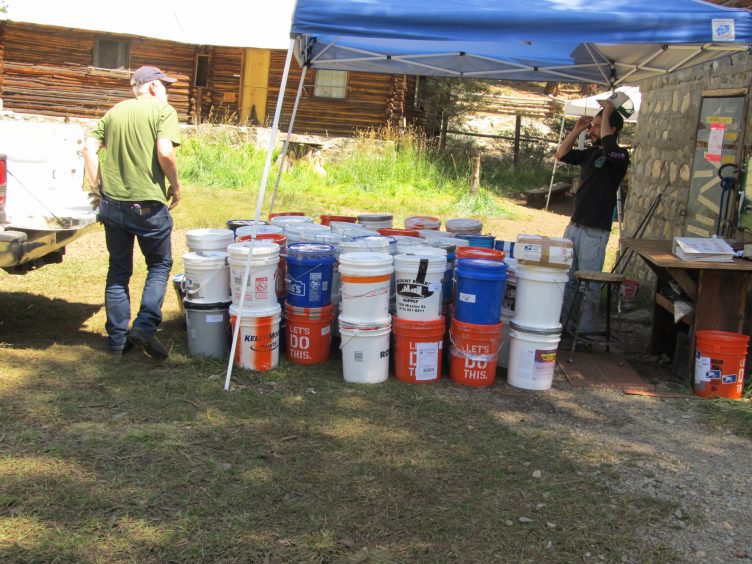
MTR staff unloading one day’s worth of resupply buckets–it’s a huge operation.
Here is where it gets tricky. This 110-mile stretch from MTR to Whitney Portal has no on-trail resupply options. Also, the highest elevation passes on the JMT (12,000 to 14,505 feet) are in this section, which can slow even the fittest PCT hikers. This translates to more than ten days for many JMT hikers, depending on how fast they can hike with a fully loaded pack at high elevation. There are a few options but none is as convenient as those available in the northern part.
Hikers can depart from the JMT to access Parchers Resort near Bishop via Bishop Pass, a journey of 12 miles. A resupply package may be mailed to the Resort ahead of time and they will hold it for 30 days for a fee. They will accept a drop off of resupply packages as well. They have the South Fork Cafe, a grocery store, laundry facilities and showers.
Hikers can leave the JMT on the Kearsarge Pass Trail, a 7.3-mile lateral trail, over Kearsarge Pass (elevation 11,709 feet) to reach Onion Valley (elevation 9,600 feet). The Kearsarge Pass Trail junction is about 70 miles from Muir Trail Ranch. Onion Valley has a campground (no amenities), parking area, pit toilets and several bear-proof food boxes. A 13.2-mile paved road connects Onion Valley to the tiny town of Independence (elevation 3,930 feet; population 669) on Highway 395, the major transportation route on the eastern side of the Sierra.
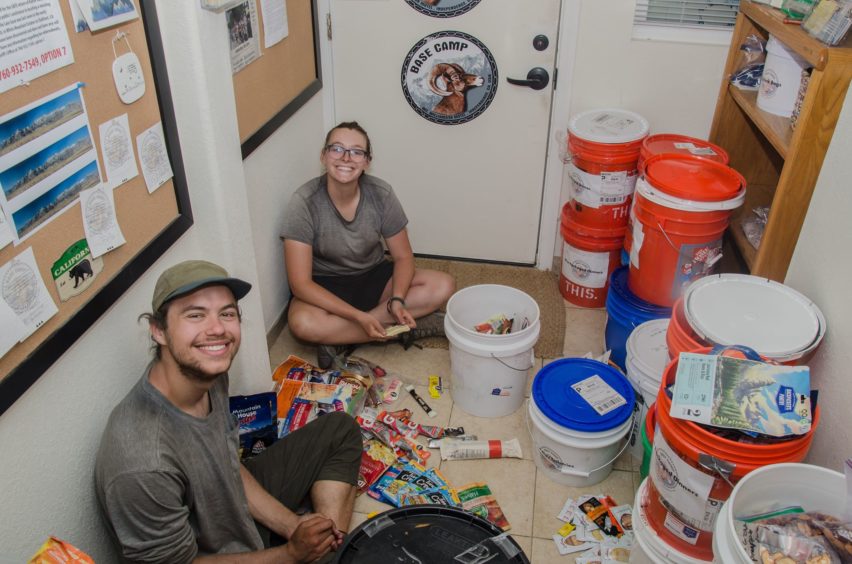
Happy campers resupplying at the Mt. Williamson Motel and Base Camp (courtesy of Lauralyn Hundley)
Pack stations in the Sierra will provide food drops, known as dunnage drops, via mule train. There are packer stations up and down the Sierra but the two locations that meet the needs of most JMT hikers are listed below. The packer must be met in person on the trail; they will not leave supplies unattended.
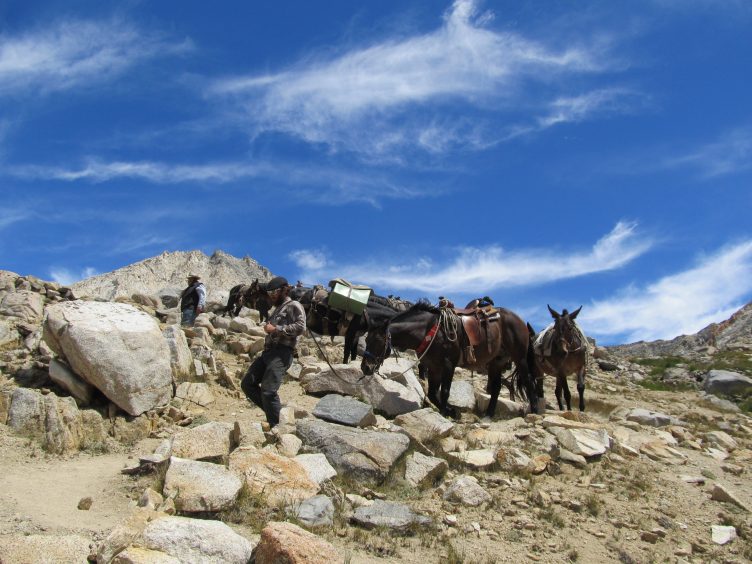
Packers on Pinchot Pass
With some planning, hikers can utilize a combination of these services to meet their resupply needs along the JMT. They have online stores and can mail to any of the resupply locations including VVR and MTR.
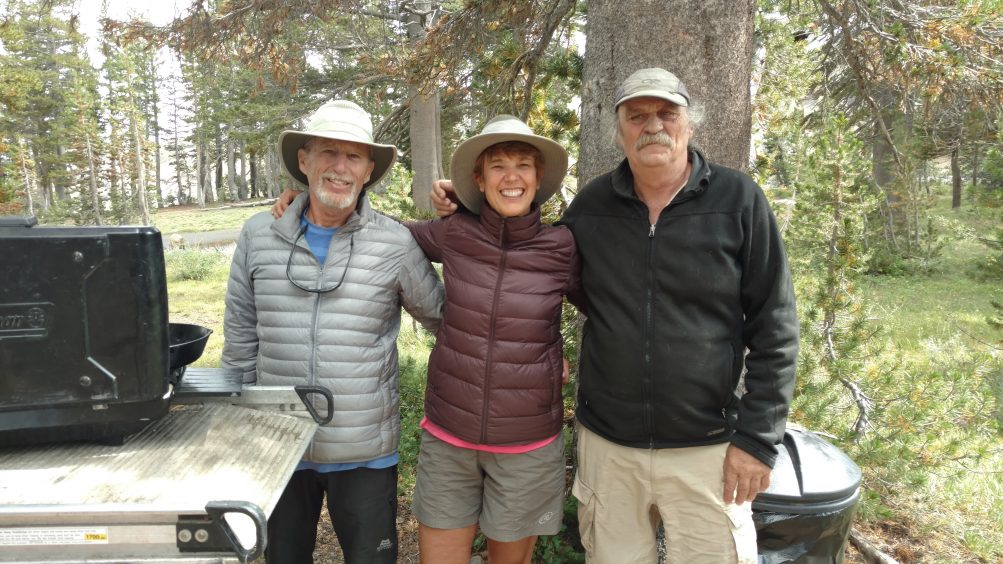
Sonora Pass Resupply–collecting our resupply from Casey Cox at Sonora Pass (not on the JMT and closed in 2020)
Regulations from the U.S. Customs and Border Protection restrict the types of food that may be brought into the United States. Food must be declared upon entry. Most commercial products in their original packaging are allowed, except meats. Fresh fruits and vegetables may also be restricted.
When I travel overseas, I bring snacks I like, some freeze-dried foods in original packaging and extra zip-lock bags. When I arrive, I transfer bulky food into the bags to reduce packaging and weight. I shop locally to supplement what we bring.
I recommend bringing some foods you know you like, especially for the first leg of the journey. For resupply food drops, I would either shop at the locations that have stores (Tuolumne Meadows, Red’s Meadow, VVR) or order from online sources (see “Mailing Services” above) to have food mailed to MTR. For the section from MTR to the end, you’ll face the same situation as others (see options listed above).
It takes some planning but thankfully there are many options for arranging a resupply on the John Muir Trail.
Related Articles
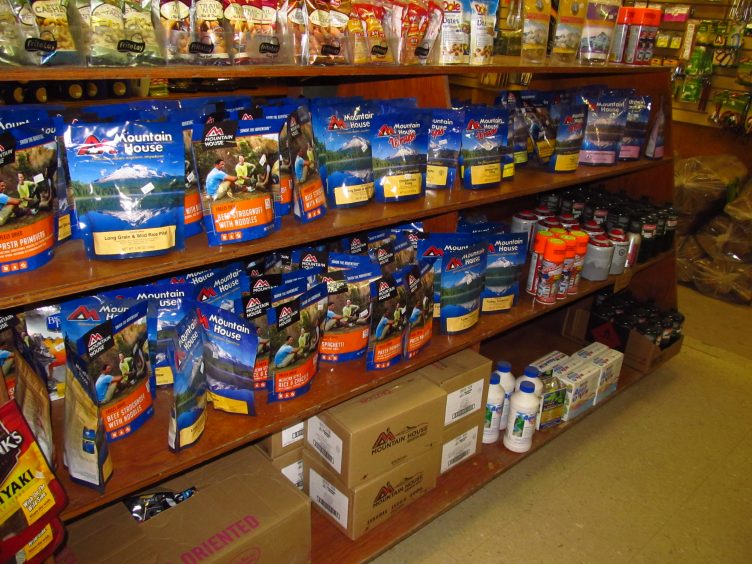
Red’s Meadow Resort had a good supply of Mountain House meals but inventory levels may vary.
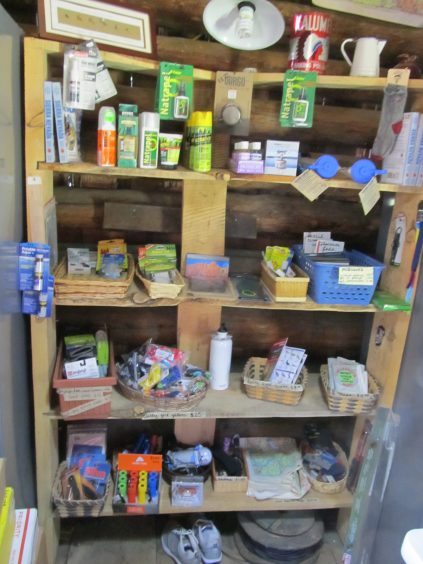
The store at Muir Trail Ranch has only a few sundries.
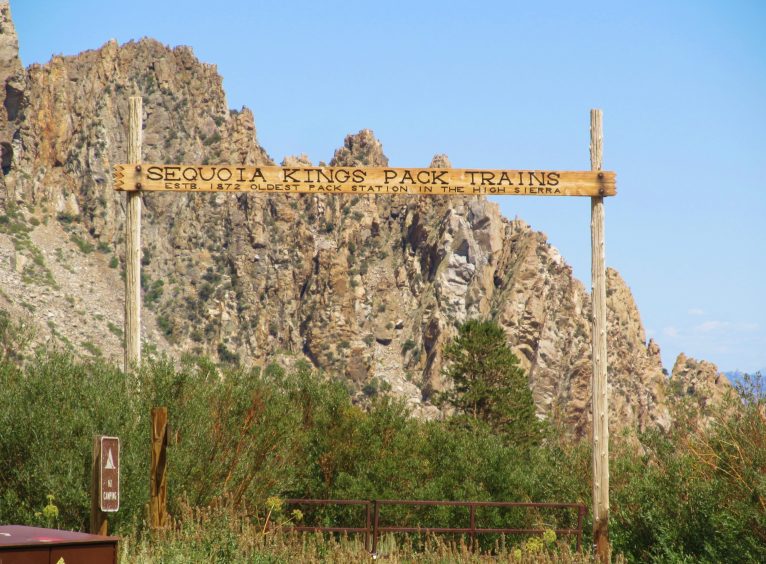
Sequoia Kings Pack Trains is located at Onion Valley.
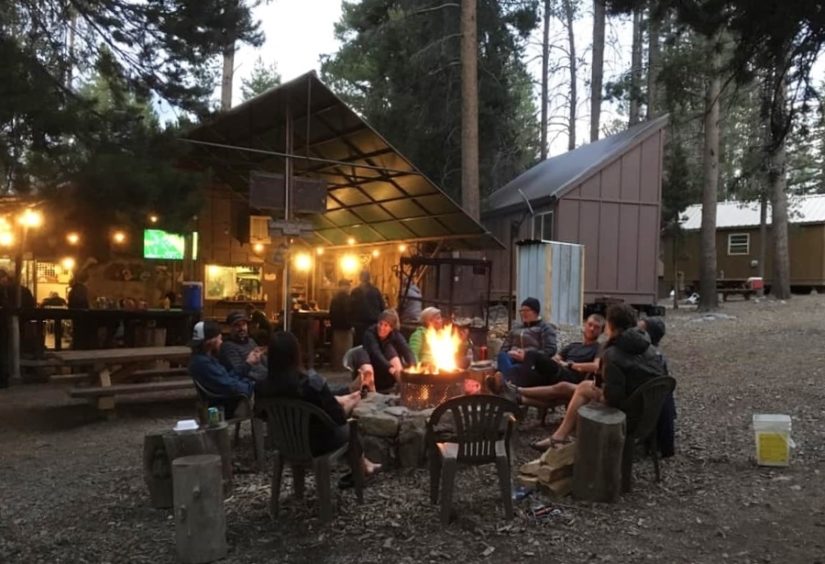
 Previous Post
Previous Post

Inga says:
Thank you to Peter Hirst, who clarified the new resupply rules with Inyo NF: “I have some further info on the new policy Inyo has announced athttps://www.fs.usda.gov/main/inyo/passes-permits/recreation, at the “What permit do I need?” tab. The most important thing to understand I think is that this is not unilateral action of the part of Inyo. After a recent interagency meeting, an agreement was reached by all 4 JMT agencies, adopting a uniform policy. This means that all previous comments about differences among treatment by YOSE, Inyo, Sierra, and SEKI have been superseded. First, Tuolumne BP, Red’s, Parchers, OV, VVR MTR and Cedar Grove will have the same deal. Stay overnight. resup at the usual places, including Tuolumne store/grill, but do not leave the area, and do not so much as hitch a ride: no shuttle, even in Tioga Road area. One exception is the VVR/Edison Ferry. It will be permitted. At Bishop Pass, use only the pack trail to Parchers: walking on the road will void your permit. The interagency idea is to encourage a more consistent interpretation of “continuous WILDERNESS travel” eliminating elements such as vehicular transportation, town zeros etc that are not consistent with that. * That said, one or two specifics remain to be clarified. One is the 24 hour rule at Road’s End. Last year I had to get to Cedar Grove and back to Road’s end same day, no overnight. This year with no hitching permitted, that would not be possible, so anyone interested in resup at Cedar Grove should deal directly with SEKI. ALso, no U-Turn at Road’s end: if you go down Wood’s to resup, you can’t go back up Woods, You have to continue on presumably Copper Creek of Bubbs. I don’t see how that is necessary to support the uniform policy, so check directly with SeKI on that one, too.”